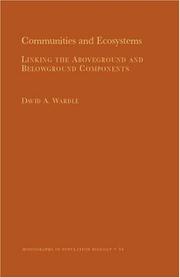| Listing 1 - 5 of 5 |
Sort by
|
Book
Year: 2013 Publisher: [Reston, Va.] : U.S. Department of the Interior, U.S. Geological Survey,
Abstract | Keywords | Export | Availability | Bookmark
 Loading...
Loading...Choose an application
- Reference Manager
- EndNote
- RefWorks (Direct export to RefWorks)
Fish populations --- Food chains (Ecology) --- Fisheries --- Habitat
Book
Year: 2013 Publisher: [Reston, Va.] : U.S. Department of the Interior, U.S. Geological Survey,
Abstract | Keywords | Export | Availability | Bookmark
 Loading...
Loading...Choose an application
- Reference Manager
- EndNote
- RefWorks (Direct export to RefWorks)
Fish populations --- Food chains (Ecology) --- Fisheries --- Habitat
Book
ISBN: 9780470973547 Year: 2013 Publisher: Chichester, West Sussex, UK : Wiley-Blackwell,
Abstract | Keywords | Export | Availability | Bookmark
 Loading...
Loading...Choose an application
- Reference Manager
- EndNote
- RefWorks (Direct export to RefWorks)
Biodiversity --- Food chains --- population dynamics --- Mathematical models --- Trophic levels --- Biological competition --- Biodiversity. --- Food chains (Ecology) --- Ecology --- Diet partitioning --- Mathematical models. --- Diet partitioning

ISBN: 0691074879 0691074860 140084729X 1299051472 9781400847297 9780691074870 9780691074863 9780691074870 Year: 2013 Volume: 34 Publisher: Princeton, NJ
Abstract | Keywords | Export | Availability | Bookmark
 Loading...
Loading...Choose an application
- Reference Manager
- EndNote
- RefWorks (Direct export to RefWorks)
Most of the earth's terrestrial species live in the soil. These organisms, which include many thousands of species of fungi and nematodes, shape aboveground plant and animal life as well as our climate and atmosphere. Indeed, all terrestrial ecosystems consist of interdependent aboveground and belowground compartments. Despite this, aboveground and belowground ecology have been conducted largely in isolation. This book represents the first major synthesis to focus explicitly on the connections between aboveground and belowground subsystems--and their importance for community structure and ecosystem functioning. David Wardle integrates a vast body of literature from numerous fields--including population ecology, ecosystem ecology, ecophysiology, ecological theory, soil science, and global-change biology--to explain the key conceptual issues relating to how aboveground and belowground communities affect one another and the processes that each component carries out. He then applies these concepts to a host of critical questions, including the regulation and function of biodiversity as well as the consequences of human-induced global change in the form of biological invasions, extinctions, atmospheric carbon-dioxide enrichment, nitrogen deposition, land-use change, and global warming. Through ambitious theoretical synthesis and a tremendous range of examples, Wardle shows that the key biotic drivers of community and ecosystem properties involve linkages between aboveground and belowground food webs, biotic interaction, the spatial and temporal dynamics of component organisms, and, ultimately, the ecophysiological traits of those organisms that emerge as ecological drivers. His conclusions will propel theoretical and empirical work throughout ecology.
General ecology and biosociology --- Food chains (Ecology) --- Soil ecology. --- Environmental Sciences and Forestry. Ecology --- Ecology (General) --- Food chains (Ecology). --- Ecology (General). --- Food webs (Ecology) --- Edaphology --- Animals --- Biological productivity --- Ecology --- Niche (Ecology) --- Nutrient cycles --- Soils --- Roots (Botany) --- Food --- Environmental aspects --- Trophic ecology
Book
ISBN: 3642339883 3642443990 3642339891 1299337910 Year: 2013 Publisher: Berlin ; Heidelberg : Springer,
Abstract | Keywords | Export | Availability | Bookmark
 Loading...
Loading...Choose an application
- Reference Manager
- EndNote
- RefWorks (Direct export to RefWorks)
With over 43,000 species, spiders are the largest predacious arthropod group. They have developed key characteristics such as multi-purpose silk types, venoms consisting of hundreds of components, locomotion driven by muscles and hydraulic pressure, a highly evolved key-lock mechanism between the complex genital structures, and many more unique features. After 300 million years of evolutionary refinement, spiders are present in all land habitats and represent one of the most successful groups of terrestrial organisms. Ecophysiology combines functional and evolutionary aspects of morphology, physiology, biochemistry and molecular biology with ecology. Cutting-edge science in spiders focuses on the circulatory and respiratory system, locomotion and dispersal abilities, the immune system, endosymbionts and pathogens, chemical communication, gland secretions, venom components, silk structure, structure and perception of colours as well as nutritional requirements. Spiders are valuable indicator species in agroecosystems and for conservation biology. Modern transfer and application technologies research spiders and their products with respect to their value for biomimetics, material sciences, and the agrochemical and pharmaceutical industries.
Food chains (Ecology). --- Spider populations. --- Spiders -- Ecology. --- Spiders -- Ecophysiology. --- Spiders --- Human Anatomy & Physiology --- Zoology --- Health & Biological Sciences --- Physiology --- Invertebrates & Protozoa --- Ecophysiology --- Anatomy --- Ecology --- Spider --- Zoology. --- Physiology. --- Araneae --- Araneida --- Life sciences. --- Biochemistry. --- Animal ecology. --- Animal anatomy. --- Animal physiology. --- Invertebrates. --- Life Sciences. --- Animal Physiology. --- Animal Biochemistry. --- Animal Ecology. --- Animal Anatomy / Morphology / Histology. --- Biology --- Natural history --- Animals --- Morphology (Animals). --- Animal morphology --- Body form in animals --- Morphology --- Biological chemistry --- Chemical composition of organisms --- Organisms --- Physiological chemistry --- Chemistry --- Medical sciences --- Invertebrata --- Animal physiology --- Composition --- Animal anatomy
| Listing 1 - 5 of 5 |
Sort by
|

 Search
Search Feedback
Feedback About UniCat
About UniCat  Help
Help News
News